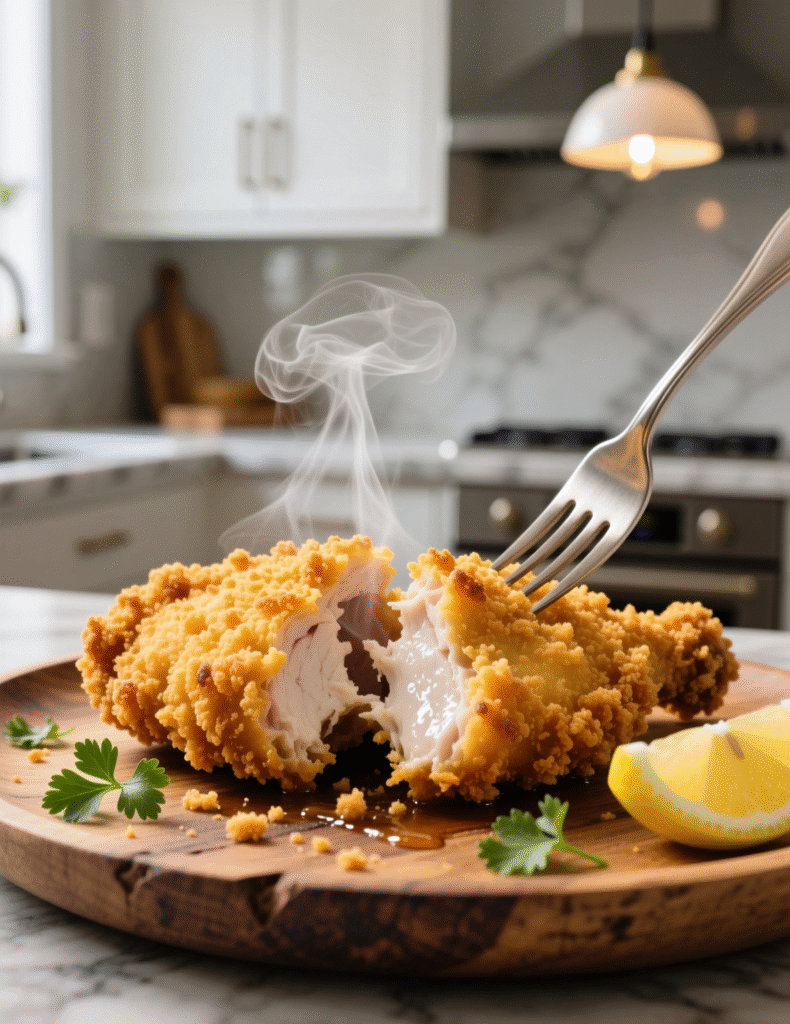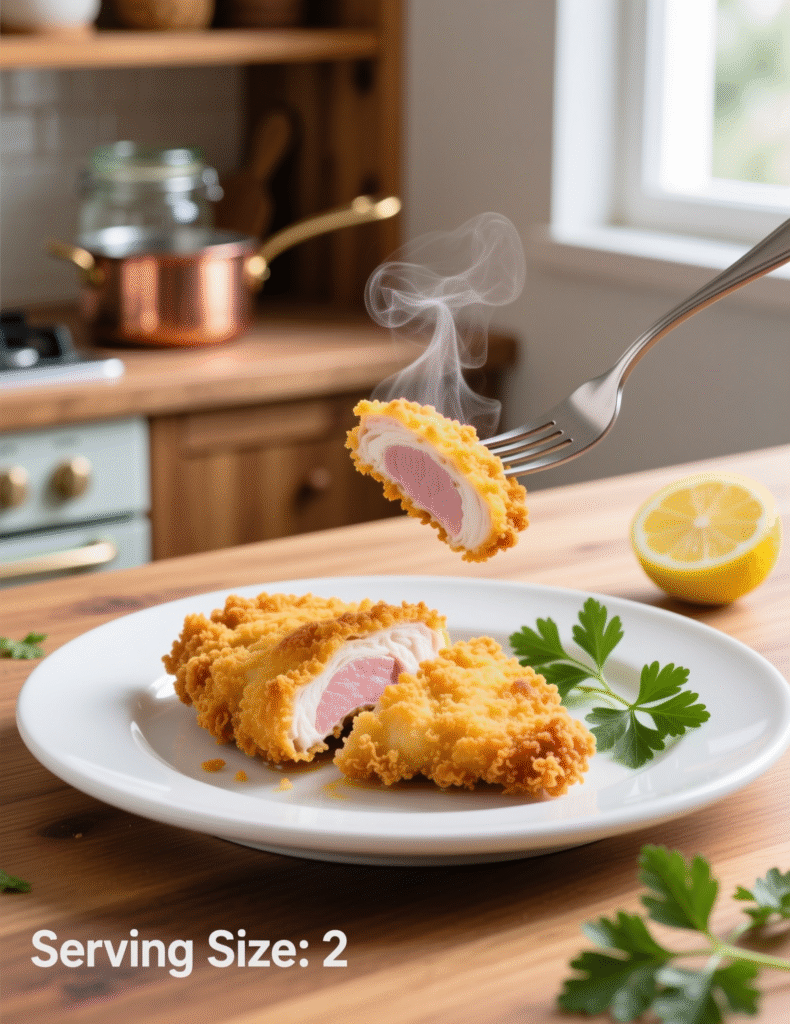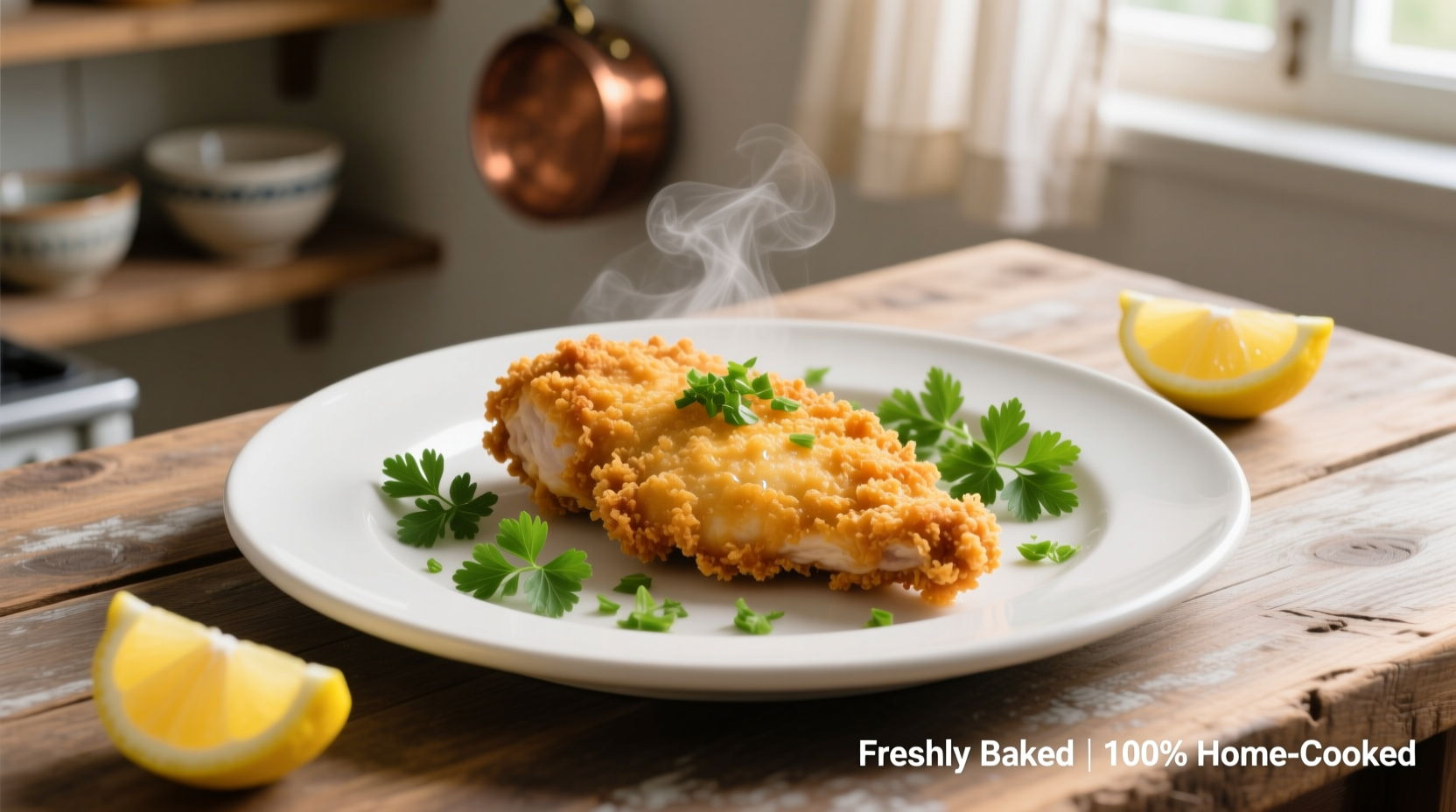There’s a moment when you bite into chicken and the coating shatters just a little before the juicy meat inside announces itself. That crunch—light but decisive—is exactly why air fryers have stolen the show in so many kitchens. Today we’re going deep into how to create the ultimate crispy air fryer breaded chicken breast recipe for 2 servings, but with the kind of detail and nuance that professional cooks lean on when precision matters.
Why Air Fryer Chicken Breasts Work So Well
Air fryers aren’t magic ovens, but they mimic deep-frying in a surprisingly efficient way. A high-powered fan circulates hot air around the food, producing a Maillard reaction on the surface without drowning the protein in oil. When you coat chicken with crumbs and seasonings, the surface dries, browns, and crisps—while the meat beneath holds on to moisture.
Chicken breasts are tricky though. They’re lean, sometimes almost too lean. Without skin or fat, they dry out faster than thighs. The air fryer mitigates this risk by cooking quickly at high heat, reducing the time for moisture loss. This is also why breading is more than flavor—it acts as insulation.
Ingredients for 2 Servings
You don’t need a shopping cart of ingredients. But the details, the ratios, and the order in which they’re applied will decide whether you get crunchy perfection or a sad, soggy slab.
- 2 boneless, skinless chicken breasts (about 6–7 oz each, pounded evenly to ¾ inch)
- ½ cup all-purpose flour
- 1 large egg, beaten with 1 tsp water
- 1 cup panko breadcrumbs (Japanese-style for maximum crunch)
- 2 tbsp grated Parmesan cheese
- 1 tsp garlic powder
- 1 tsp onion powder
- 1 tsp smoked paprika
- ½ tsp black pepper
- 1 tsp kosher salt (divided)
- Olive oil spray (don’t drench, just mist lightly)
Panko is non-negotiable here. Regular breadcrumbs simply won’t produce the same crackle. Parmesan doesn’t just add flavor—it also melts and re-hardens in tiny pockets, amplifying crispness.

Step-By-Step Cooking Method
1. Preparing the Chicken
Trim any excess fat or sinew. Place the breasts between sheets of parchment and pound gently until uniform in thickness. Uneven meat cooks unevenly, which leads to dry edges and undercooked centers. That’s the kind of amateur mistake pros avoid instinctively.
2. Seasoning
Sprinkle half the salt directly onto the chicken before dredging. This step matters. If you only season the crumbs, you’ll find the meat itself bland while the crust does all the heavy lifting. Balanced seasoning means seasoning in layers.
3. Dredging
Set up your dredge station—flour in one shallow bowl, egg wash in the second, breadcrumb mixture in the third. Work clean. Left hand for dry, right hand for wet, or you’ll gum up your fingertips like glue. Coat the chicken lightly in flour first, shaking off excess. Then dip in egg wash until coated but not dripping. Press firmly into the panko mixture. That press is not decoration—it’s adhesion science.
4. Preheating and Spraying
Preheat the air fryer to 375°F (190°C) for at least 3 minutes. Cold baskets kill crisping because they delay the browning window. Spray the coated chicken lightly with olive oil. Don’t soak it. Too much oil prevents air circulation, too little leaves you with pale crust.
5. Air Frying
Arrange breasts in the basket without overlap. Crowding = steaming, and steaming means rubbery disaster. Cook at 375°F for 10 minutes. Flip gently with tongs, spray again, and cook for 8–10 minutes more. Internal temp should hit 165°F (74°C). Pull them out a hair earlier if you plan on carryover cooking.
6. Resting
Rest the chicken on a rack for 3 minutes. Straight onto a plate? Nope. Steam will gather beneath and soften the base. Use a wire rack. Professionals treat crust like it’s glass—handle carefully or you break it.
The Science Behind the Crunch
Why panko? Its irregular shape allows hot air to attack from more angles. Flat crumbs compress too much and create dense shells instead of airy crusts. Parmesan contributes glutamates, which deepen flavor, but also hardens in micro-crystals. Garlic and onion powders give volatile compounds that bloom faster in dry heat.
Moisture retention is key. Studies in Food Hydrocolloids Journal show that coating proteins in starch before frying reduces water loss by up to 15%. The flour layer here is more than ritual—it’s a barrier.
Nutritional Considerations
A deep-fried chicken breast of similar size often carries 18–20 grams of fat. With this air fryer method, you’re closer to 8–10 grams, depending on how generously you spray oil. Calories hover around 300–320 per serving, with 32–35 grams of protein. For clients watching fat intake but still craving indulgence, this recipe slots neatly into a balanced plan.

Professional Insights: Avoiding Common Errors
- Overcrowding the basket – professionals often cook in batches instead. Two breasts are fine, four is pushing it.
- Skipping the preheat – the browning curve is lost if the chamber starts cold.
- Forgetting carryover cooking – chicken breast rises 3–4°F after removal. Pull at 162°F if you’re nervous about dryness.
- Uneven thickness – pounded meat ensures that both ends reach doneness at the same time.
Variations for Professionals
Spiced Crust
Add cayenne and cumin for a more aggressive crust. Works beautifully for fusion menus.
Herbaceous Crumb
Blend parsley, thyme, and basil into the panko mixture. This creates green flecks that pop on the golden crust.
Gluten-Free Option
Rice flour and crushed cornflakes mimic the texture. Air fryers don’t discriminate.
Buttermilk Brine
For extra juiciness, soak breasts in buttermilk for 2 hours before dredging. Acidity breaks down some muscle fibers, keeping moisture locked in.
Real-World Application in Professional Kitchens
Catering chefs often use air fryers not just for health claims but also for speed. A commercial convection oven might take 25 minutes to crisp small batches. Air fryers halve that. In smaller kitchens or pop-up events, the footprint of an air fryer means it can replace larger equipment when serving limited menus.
Data from the National Restaurant Association suggests 42% of US restaurants experimented with air fryer menu items in 2024. The growth is tied to consumer demand for “indulgent but healthy” foods. Crispy chicken fits the bill exactly.
Addressing Misconceptions
Some argue air fryers don’t match the depth of flavor of deep-fried chicken. True, the oil bath imparts unique compounds. But with high-quality seasonings, parmesan, and correct air circulation, you reach 90% of that experience. For many customers, the health trade-off makes it the smarter choice.
Another myth: “Oil spray isn’t necessary.” Absolutely false. Without oil, panko won’t brown properly, leaving pale crumbs that taste raw. The mist acts as a browning catalyst.
Emerging Trends
Chefs now experiment with double-breading for air fryer chicken. Flour → egg → crumbs → repeat egg → crumbs again. This produces a more robust shell, closer to Korean fried chicken styles. Another trend is flavoring the crumbs themselves with dehydrated vegetables like beet powder for color contrast. Expect to see menu items like “Pink-Crust Chicken Bites” in modern bistros.
Serving Suggestions
Pair with a crisp salad of arugula and lemon vinaigrette. Acid cuts through richness. For comfort plating, serve with mashed potatoes, but add roasted garlic into the mash for depth. Some pros drizzle honey over the crust just before serving—a sweet-savory interplay that customers remember.
Conclusion
The secret to crispy air fryer breaded chicken breast isn’t in flashy tricks but in small disciplines: preheating, seasoning layers, proper dredging, and not overcrowding. When done with attention, the crust shatters lightly, the interior stays tender, and the whole dish balances health with indulgence.
For professionals, this recipe offers consistency and speed without compromising flavor. For home cooks, it feels like restaurant-style without the grease. The future of frying, it seems, hums with a fan instead of bubbling in oil.
FAQs
What’s the best type of breadcrumbs for air fryer chicken?
Panko breadcrumbs give the crispiest texture compared to regular breadcrumbs.
Do I need to preheat the air fryer?
Yes, preheating ensures even browning and a crunchy crust.
Can I use frozen chicken breasts?
Yes, but thaw completely for even cooking and proper crisping.
How much oil should I use?
Just a light spray to help the crust brown; don’t soak the chicken.
What temperature should I cook the chicken at?
375°F (190°C) is ideal for juicy, crispy results.
How long do I cook chicken breasts in the air fryer?
About 10 minutes per side, flipping halfway, until 165°F internal temp.
Can I make this recipe gluten-free?
Yes, use rice flour and crushed cornflakes or gluten-free panko.
Do I need to pound the chicken breasts?
Yes, for even thickness and consistent cooking throughout.
Can I add extra flavor to the crust?
Absolutely, herbs, spices, or Parmesan enhance both flavor and crunch.
Should I rest the chicken after cooking?
Yes, 2–3 minutes on a wire rack preserves the crispiness.

Mariana is a passionate home cook who creates delicious, easy-to-follow recipes for busy people. From energizing breakfasts to satisfying dinners and indulgent desserts, her dishes are designed to fuel both your body and hustle.
When she’s not in the kitchen, she’s exploring new flavors and dreaming up her next recipe to share with the Foodie Hustle community.

